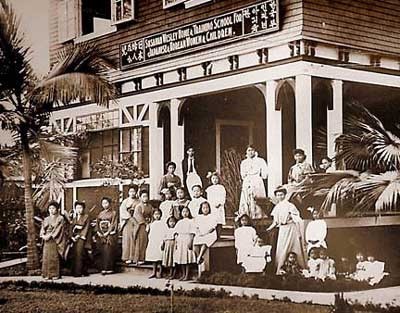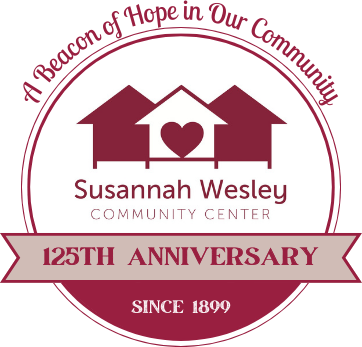 In 1899 the Women’s Home Missionary Society, of what is now known as The United Methodist Church, sent missionary Ms. Ella Holbrook to Hawaii to reach out to Japanese and Korean immigrant women working on the plantations of Waipahu, Oahu. Her goal was to provide English and sewing classes to the women. Within a few short years, a succession of female missionaries established a home for girls who were orphaned, abandoned, or whose parents were unable to care for them. The “Susannah Wesley Home,” named in honor of the mother of Methodist Movement founder John Wesley, housed over a hundred girls at a time for nearly four decades, providing a loving, learning environment that enabled girls to grow up to become independent, responsible, contributing adults. The girls of the Home ranged in age from 4 to 20 and became known as the “Susie Girls.”
In 1899 the Women’s Home Missionary Society, of what is now known as The United Methodist Church, sent missionary Ms. Ella Holbrook to Hawaii to reach out to Japanese and Korean immigrant women working on the plantations of Waipahu, Oahu. Her goal was to provide English and sewing classes to the women. Within a few short years, a succession of female missionaries established a home for girls who were orphaned, abandoned, or whose parents were unable to care for them. The “Susannah Wesley Home,” named in honor of the mother of Methodist Movement founder John Wesley, housed over a hundred girls at a time for nearly four decades, providing a loving, learning environment that enabled girls to grow up to become independent, responsible, contributing adults. The girls of the Home ranged in age from 4 to 20 and became known as the “Susie Girls.”
When the need for “orphanages” decreased, the Susannah Wesley Community Center (SWCC) emerged as a multi‐purpose agency serving the needs of a diverse population. The Center’s offerings have included a nursery school, playground, after‐school clubs for youth and English classes for adults. Soon SWCC provided outreach services, Head Start classes, study hall programs and expanded its work to include mental health services for youth and adults. For more than 100 years, programs and services have been configured and reconfigured as community needs dictate.
Timeline
 The following timeline highlights key milestones in our organizational history as we have grown and changed to meet the diverse needs of our community throughout the first 100 years and into our second century:
The following timeline highlights key milestones in our organizational history as we have grown and changed to meet the diverse needs of our community throughout the first 100 years and into our second century:
1899: A $500 appropriation from the Women’s House Mission Society of the Methodist Episcopal Church sends Miss Holbrook, a missionary, into Waipahu to make house-to-house visits with Japanese women on the plantation. She organizes English language and sewing classes.
1903: Elizabeth J. Blois cares for unattended plantation children in a small rented cottage with a $500 appropriation for the Women’s Home Missionary society. She names the cottage the Susannah Wesley Home & Training School for Japanese and Korean Women & Children in honor of the mother of John Wesley, founder of the Methodist Movement.
1919: The Home moves to its present location on Kaili Street in Kalihi. It is renovated to accommodate 100 girls of diverse ages and ethnic backgrounds. Many old-timers in Hawaii still remember SWCC as a home for girls.
1956: Responding to the decreasing need for orphanages, the Home converts to a treatment center for young children with serious emotional and behavioral problems. Due to difficulties with funding and finding qualified workers, the decision is made to close the treatment center in less than a year.
 1957: Reorganized and refocused on community needs, Susannah Wesley Community Center (SWCC) starts a multi-service center with a nursery school, playground, after-school boys and girls clubs and adult English classes.
1957: Reorganized and refocused on community needs, Susannah Wesley Community Center (SWCC) starts a multi-service center with a nursery school, playground, after-school boys and girls clubs and adult English classes.
1960s:
- An Outreach Service program is established to organized the first Head Start classes and study hall programs in public housing facilities and neighborhood schools. SWCC operated five Head Start sites in the Kalihi community during this decade as part of the “War on Poverty.”
- SWCC pioneers bi-lingual outreach services to new immigrants arriving from the Pacific Basin, setting groundwork for its future work with new arrivals in Hawaii.
- The present Ewa wing of the Center’s Kaili Street facility is completed and dedicated in 1967.
- SWCC becomes incorporated on February 13, 1968, by the state of Hawaii Department of Regulatory Agencies.
1970s:
- SWCC, in coordination with other agencies, initiates a demonstration project for the elderly. This is the forerunner of the current island-wide senior citizens’ meal delivery program.
- Aloha United Way (AUW) negotiates the merger of SWCC and the Pastoral Counseling Service and Kuhio Park Terrace (KPT), creating Hui Kokua, an on-site agency program at KPT public housing. Today, the program is AUW’s primary site for food and material donations distribution.
- SWCC initiates a collaborative effort to found the Interagency Council for Immigrant and Refugee Services (IAC), which assists immigrants throughout Oahu and advocates on their behalf. This group continues to meet at the Center.
- The Youth Intake Center is established to provide youth and family counseling services in Kalihi-Palama.
- The Immigrant Services Program is formally established to assist new arrivals to the State and our community.
- “Family Power,” a parent education program is started. A bi-lingual curriculum is later completed.
1980s:
- SWCC establishes an outpatient treatment and prevention education program to address the growing alcohol consumption abuse problems in the Kalihi-Palama community.
- The Youth Intake Center and Immigrant Services Program establish office sites in Waipahu.
- SWCC implements prevention and youth development programs and coordinates with the State and non-profit agencies to deter youth from drug abuse, youth gangs and diversion from the juvenile justice system.
- SWCC becomes part of the State’s Youth Gang Response System and is located on-site at the Honolulu Police Department’s Juvenile Crime Prevention Division.
- The Kuhio Park Terrace Family Center, a collaborative effort of on-site agencies at Kuhio Park Terrace, begins operations.
1990s:
- The Immigrant Refugee Support Services Program is launched. The program provides bi-lingual Asian and Pacific Basin mental health services.
- The Harry and Jeanette Weinberg Youth Center opens its doors in 1997 at the Kaili Street site.
- The Leeward Ohana Project, a child and adolescent mental health program, is opened to Leeward Oahu children as a demonstration project. The array of mental health services provided became the model for services delivered by the State today.
- The SWCC is accredited in 1998 by the Council on Accreditation (COA) as part of the agency’s strategic goal of achieving excellence in governance and operations.
2000s:
- Various youth and bi-lingual adult employment training programs are initiated at SWCC throughout the decade.
- The SWCC Competency Based High School Diploma Program (C-Base) graduates its first class in 2003. Over 250 youth have since graduated from the program.
- In 2006 Project Ho‘omahala provides transition age services to youth facing serious emotional and social challenges. The program is a demonstration project in coordination with the State’s Children and Adolescent Mental Health Division and the University of Hawaii Center on Disability Studies. This program ended in 2012.
- Services to help Human Trafficking victims begins in 2009.
 2010s:
2010s:
- SWCC resumes family education and parenting programs.
- Immigrant Resource Center opens in early 2014.
- In March 2015, the Kalihi Palama Juvenile Assessment Center, a civil citation program opens.
